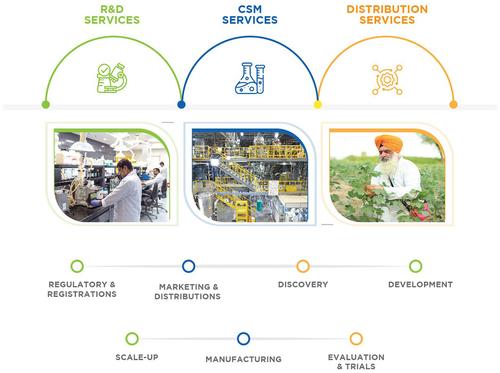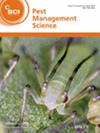求助PDF
{"title":"提高作物保护研发的合作商数--多学科交叉学习促进可持续性。","authors":"Sunil Kumar Mandal, Mayank Singhal","doi":"10.1002/ps.8540","DOIUrl":null,"url":null,"abstract":"<p><p>After a decade of consolidation with a focus on top market players, global crop protection research is undergoing a paradigm transition by integrating new cutting-edge technologies originating from established and new research organizations. Both development and distribution organizations are working together to make these innovations available to the global farming community. For this, excellent crop protection products are in demand, creating value for farmers and society with superior biological performance and at the same time very high product safety profiles. However, the enormous constraints researchers are exposed to, require the discovery and development of innovative solutions in the shortest possible time frame, while embracing environmental, social, and governance (ESG) objectives as the new normal across the whole industry. Today, fully integrated research and development (R&D) companies are addressing the whole plethora of agrochemistry, biologicals and plant health products, organic farming, seeds and traits, new application technologies, digital farming, improved diagnostics, artificial intelligence (AI), and machine learning (ML)-based approaches. However, there is still a strong need for further innovations from a wide range of sources. Targeted collaboration across various market players is key to combining required activities. This mandates a high level of discipline to frame the proprietary and knowledge environment across the industry. Furthermore, the cooperation of industry and academia will enable an extra push for innovation in the crop protection landscape. Current trends and suggestions are given of how collaborations need to be framed within the industry as well as within the public sector. © 2024 Society of Chemical Industry.</p>","PeriodicalId":218,"journal":{"name":"Pest Management Science","volume":" ","pages":""},"PeriodicalIF":3.8000,"publicationDate":"2024-11-19","publicationTypes":"Journal Article","fieldsOfStudy":null,"isOpenAccess":false,"openAccessPdf":"","citationCount":"0","resultStr":"{\"title\":\"Enhancing collaboration quotient in crop protection research and development - multi-disciplinary cross-learning to promote sustainability.\",\"authors\":\"Sunil Kumar Mandal, Mayank Singhal\",\"doi\":\"10.1002/ps.8540\",\"DOIUrl\":null,\"url\":null,\"abstract\":\"<p><p>After a decade of consolidation with a focus on top market players, global crop protection research is undergoing a paradigm transition by integrating new cutting-edge technologies originating from established and new research organizations. Both development and distribution organizations are working together to make these innovations available to the global farming community. For this, excellent crop protection products are in demand, creating value for farmers and society with superior biological performance and at the same time very high product safety profiles. However, the enormous constraints researchers are exposed to, require the discovery and development of innovative solutions in the shortest possible time frame, while embracing environmental, social, and governance (ESG) objectives as the new normal across the whole industry. Today, fully integrated research and development (R&D) companies are addressing the whole plethora of agrochemistry, biologicals and plant health products, organic farming, seeds and traits, new application technologies, digital farming, improved diagnostics, artificial intelligence (AI), and machine learning (ML)-based approaches. However, there is still a strong need for further innovations from a wide range of sources. Targeted collaboration across various market players is key to combining required activities. This mandates a high level of discipline to frame the proprietary and knowledge environment across the industry. Furthermore, the cooperation of industry and academia will enable an extra push for innovation in the crop protection landscape. Current trends and suggestions are given of how collaborations need to be framed within the industry as well as within the public sector. © 2024 Society of Chemical Industry.</p>\",\"PeriodicalId\":218,\"journal\":{\"name\":\"Pest Management Science\",\"volume\":\" \",\"pages\":\"\"},\"PeriodicalIF\":3.8000,\"publicationDate\":\"2024-11-19\",\"publicationTypes\":\"Journal Article\",\"fieldsOfStudy\":null,\"isOpenAccess\":false,\"openAccessPdf\":\"\",\"citationCount\":\"0\",\"resultStr\":null,\"platform\":\"Semanticscholar\",\"paperid\":null,\"PeriodicalName\":\"Pest Management Science\",\"FirstCategoryId\":\"97\",\"ListUrlMain\":\"https://doi.org/10.1002/ps.8540\",\"RegionNum\":1,\"RegionCategory\":\"农林科学\",\"ArticlePicture\":[],\"TitleCN\":null,\"AbstractTextCN\":null,\"PMCID\":null,\"EPubDate\":\"\",\"PubModel\":\"\",\"JCR\":\"Q1\",\"JCRName\":\"AGRONOMY\",\"Score\":null,\"Total\":0}","platform":"Semanticscholar","paperid":null,"PeriodicalName":"Pest Management Science","FirstCategoryId":"97","ListUrlMain":"https://doi.org/10.1002/ps.8540","RegionNum":1,"RegionCategory":"农林科学","ArticlePicture":[],"TitleCN":null,"AbstractTextCN":null,"PMCID":null,"EPubDate":"","PubModel":"","JCR":"Q1","JCRName":"AGRONOMY","Score":null,"Total":0}
引用次数: 0
引用
批量引用



